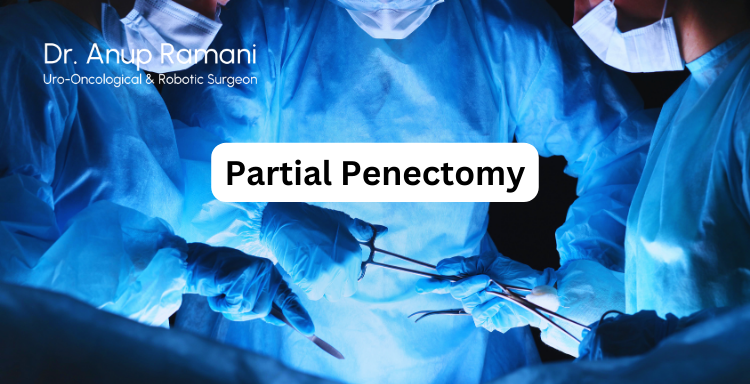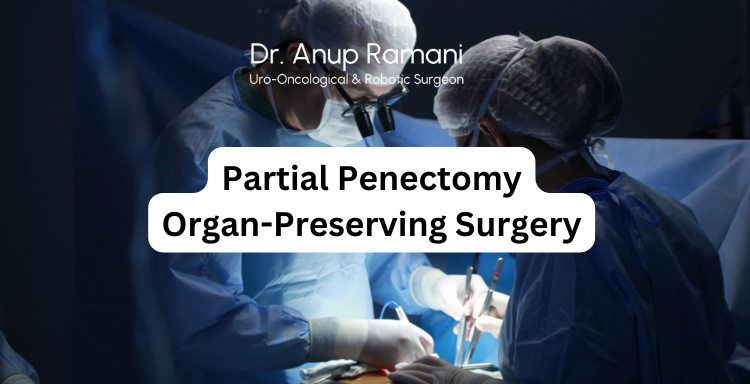Dr Anup Ramani @ Copyright 2024
By Dr. Anup Ramani
Introduction
Penis cancer, while rare, presents unique challenges for patients. When faced with a diagnosis, surgery is often the primary treatment option. For men seeking to preserve as much function and form as possible, partial penectomy offers an organ-preserving alternative. This surgery is designed to remove the cancerous tissue while maintaining the structure and functionality of the penis. In this article, we’ll take a closer look at partial penectomy, how it’s performed, its benefits, and how it helps preserve both sexual and urinary functions.
What is a Partial Penectomy?
A partial penectomy is a surgical procedure in which only the cancerous portion of the penis is removed, allowing for the preservation of as much healthy tissue as possible. The goal of this surgery is to excise the tumor while minimizing the impact on sexual and urinary functions. Partial penectomy is typically recommended for patients with localized cancer that hasn’t spread to other areas of the body and for tumors that are small enough to allow for a partial removal.

The Procedure: How Partial Penectomy is Performed
Pre-Surgical Preparation: Before surgery, patients undergo a thorough evaluation, including imaging and biopsies, to assess the size and location of the tumor. The surgeon will discuss the procedure in detail, including what to expect during recovery.
Surgical Steps:
- Anesthesia: The patient is placed under general anesthesia or regional anesthesia to ensure they are comfortable during the procedure.
- Tumor Removal: The surgeon carefully excises the tumor along with a margin of healthy tissue to ensure that all cancerous cells are removed.
- Preserving Functionality: The surgeon then reconstructs the remaining portion of the penis to maintain as much length and functionality as possible.
- Closure: The wound is closed using sutures, and the area is bandaged to promote healing.
Benefits of Partial Penectomy
Partial penectomy is highly valued for its ability to preserve both sexual and urinary functions.
Sexual Function: By maintaining part of the penis, many men are able to retain some degree of sexual sensation and erectile function.
Urinary Function: The surgery also aims to preserve the urethra, ensuring that men can continue to urinate normally. These benefits contribute significantly to a patient’s quality of life and psychological well-being post-surgery.
Comparing Partial and Total Penectomy
While partial penectomy focuses on preserving as much of the penis as possible, total penectomy involves the complete removal of the organ.
Advantages of Partial Penectomy: include reduced psychological impact, preservation of sexual function, and better cosmetic outcomes.
Total Penectomy: may be necessary for larger or more aggressive tumors, but it often results in more significant changes to a man’s body and requires more extensive reconstruction.
Candidacy for Partial Penectomy
Not all patients with penis cancer are eligible for partial penectomy. The Tumor Size and Location are key factors; smaller, localized tumors are more likely to be treated successfully with a partial approach. The Stage of Cancer is also critical-early-stage cancers are ideal candidates, whereas advanced-stage cancers may require more aggressive treatments.
Risks and Complications of Partial Penectomy
As with any surgery, partial penectomy carries risks. These can include bleeding, infection, and wound complications. Long-term, men may experience scar tissue or altered sensation in the remaining portion of the penis. There’s also the emotional impact of surgery, as men adjust to changes in their body and sexual function. Psychological support is essential for managing these adjustments.
Preservation of Sexual Function
One of the main goals of partial penectomy is the preservation of sexual function. While some changes in sensation or erectile function may occur, many men are able to continue having an active sexual life post-surgery. For those who experience difficulties, sexual rehabilitation programs and counseling can help address these challenges.
Maintaining Urinary Function Post-Surgery
Maintaining the ability to urinate normally is a key consideration during a partial penectomy. The surgeon will work to preserve the urethra, ensuring that urinary flow remains unobstructed. Some men may experience temporary changes in urinary patterns, but with the right recovery and rehabilitation efforts, these issues can often be resolved.
Recovery and Rehabilitation After Partial Penectomy
Recovery Timeline: The initial healing period typically lasts a few weeks, during which patients may need to avoid strenuous activities, including sexual intercourse.
Physical Therapy: Some men may benefit from pelvic floor exercises or other rehabilitative therapies to regain function and strength in the affected area.
Follow-up Care: Regular check-ups with the surgeon are crucial to monitor healing and ensure that there are no signs of cancer recurrence.

The Role of Reconstructive Surgery
For some men, reconstructive surgery may be an option after partial penectomy. Procedures such as phalloplasty can help restore the appearance and function of the penis. This is particularly beneficial for men who feel self-conscious about the physical changes caused by surgery.
The Psychological Impact of Partial Penectomy
Beyond the physical effects, the psychological impact of partial penectomy is significant. Many men struggle with body image issues or feelings of loss of masculinity. Counseling and support groups can be instrumental in helping men navigate these emotional challenges, providing them with the tools to rebuild their confidence and sense of self.
Patient Experiences: Real Stories of Partial Penectomy
Hearing from other men who have undergone partial penectomy can provide valuable insights and reassurance. Many patients describe the initial fear and anxiety they felt but also share how they adjusted to life post-surgery, often finding that their quality of life improved as they healed and adapted.
Follow-Up Care and Monitoring for Recurrence
After surgery, regular follow-up appointments are essential. These appointments help monitor for any signs of cancer recurrence and ensure that the patient’s recovery is on track. Screenings and tests will be part of the ongoing care plan, giving patients peace of mind and allowing for early detection of any potential issues.
Long-Term Outlook for Partial Penectomy Patients
The long-term outlook for men who undergo partial penectomy is generally positive, especially when the cancer is detected early and treated effectively. With appropriate care and emotional support, many men return to a fulfilling and active life. Quality of life considerations remain central, and men are encouraged to continue seeking support when needed.
Conclusion
Partial penectomy offers a vital option for men diagnosed with penis cancer, combining cancer control with organ preservation. By maintaining sexual and urinary functions, it allows for a better post-surgery quality of life. While the emotional and psychological impacts of surgery are significant, there are numerous resources and strategies available to help men recover both physically and mentally. If you’re facing a diagnosis, it’s important to explore all your options and speak openly with your healthcare provider about the benefits and challenges of partial penectomy.
FAQs - Partial Penectomy
How successful is partial penectomy in preserving sexual function?
Many men retain some level of sexual function, though changes in sensation or performance may occur.
What can I expect during recovery from partial penectomy?
Recovery typically involves a few weeks of rest and follow-up care, with gradual improvements in function over time.
Will I need further treatment after partial penectomy?
It depends on the stage of cancer; some men may require additional therapies, such as radiation or chemotherapy.
How long is the hospital stay for partial penectomy?
Most men stay in the hospital for 1 to 2 days post-surgery, with follow-up care taking place at home.
Are there reconstructive options if I am unhappy with the results of partial penectomy?
Yes, reconstructive surgery options are available, such as phalloplasty, to help restore appearance and function.
Table of Contents
Recent Blogs
Best Uro-Oncological surgeon
Specialist in India for Robotic Surgery
MCh, DNB, MS, DNB
Dr. Anup Ramani
CONTACT
Uro-Oncologist in India,
Best Robotic Surgeon for Uro Oncology Surgery
1407, One Lodha Place Next to World Towers Senapati Bapat Marg, Worli, Mumbai. 400013.
Dr Anup Ramani @ Copyright 2024 – Website Maintenance & SEO by Webmasterindia
- Partial penectomy is done in cases where glans and distal penis is involved with carcinoma.
- Partial penectomy is a type of organ-preserving surgery. Preservation of sexual and micturational function depends on the surgical dissection and reconstruction of residual urethra.
- Patients who develop stones in the kidney or ureter, often experience severe pain.
- This condition usually needs a procedure to remove the kidney stones.
- This procedure is called ureteroscopy and is performed very commonly.
- It does not require any cuts and hence it is painless.
- The procedure is performed with an endoscope inserted through the penis under spinal anesthesia.
- The scope is inserted through the penis into the kidney and stones are dissolved with a laser.
- The procedure takes about 40-50 minutes.
- A catheter (urine pipe) is kept after the procedure to drain the bladder. A stent is kept in the kidney at the same time.
- Patient is mobile and walking in the room the same evening.
- Hospital stay is one night and patient is discharged the next day after removal of the catheter.
- Patient has to come back after six weeks to remove the stent in the kidney.
- Patients can resume office a week after surgery and heavy activities like running, weight lifting, a month after the procedure.
- We offer fixed packages for this procedure which can be obtained by calling our helpline +91 9967666060.
- Men with an enlarged prostate, which is a normal ageing changes, often experiencing difficulty passing urine. This condition usually needs a procedure to trim the prostate and relieve the blockage.
- This procedure is called TURP and is performed very commonly.
- It does not require any cuts and hence it is painless.
- The procedure is performed with an endoscope inserted through the penis under spinal anaesthesia.
- The overgrown prostate is dissolved with a laser bloodlessly.
- The procedure takes about 40 minutes.
- A catheter (urine pipe) is kept after the procedure to drain the bladder.
- Patient is mobile and walking in the room the same evening.
- Hospital stay is two nights and patient is discharged with the catheter, which is removed after 4 days.
- Patients can resume office a week after surgery and heavy activities like running, weight lifting, a month after the procedure.
- We offer fixed packages for this procedure which can be obtained by calling our helpline +91 9967666060.
-
Robotic adrenalectomy is a sophisticated, complex surgery and it is very important that an experienced surgeon performs this surgery to avoid major complications.
-
Once the anesthesia is done, and patient positioned, three micro cuts (3mm each) are made in the patient’s abdomen.
-
The arms of the Da Vinci robot are connected to the cuts via ports (tubes).
-
Dr. Ramani then sits in the controlling console to perform the surgery.
-
On an average, a robotic adrenalectomy takes one hour.
-
The surgery is almost completely bloodless and there has never been any need to transfuse blood after surgery.
-
A urine catheter and bag to drain the bladder is inserted during surgery.
-
A tiny drain pipe may be inserted in the surgical side of the abdomen, connected to a bag.
-
Patient is kept nil-by-mouth the day of the surgery, with IV fluids. Sips of water are started the next day and solid food by day three.
-
The drain pipe, if kept, is removed in the room on day 2 after surgery.
-
The catheter is removed on day two after surgery.
-
Total hospital stay for robotic adrenalectomy is 4 nights (including night before surgery).
-
Post discharge, a doctor from the surgical team visits the patient at home/ hotel room once every day.
On the day of discharge, patient is totally self-sufficient. They are able to walk freely without any pain, dress themselves, shower, toilet and they do not need to hire any nurse or help at home. Almost all patients are back to work within 2 weeks of surgery.
Heavy activities like running, weight lifting can be resumed after a month
Follow up after an adrenalectomy is in the form of CT scans, once a year for 5 years.
Local patients usually meet Dr. Ramani after two weeks to discuss report.Outstation patients are counselled on a phone consultation.
- Dr. Ramani is one of the very few surgeons in India who has the expertise to perform a robotic surgery for bladder cancer, which includes removing the urinary bladder and reconstructing a new bladder robotically.
- Robotic radical cystectomy is an extremely sophisticated, complex surgery and it is very important that an experienced surgeon performs this surgery to avoid major complications.
- Once the anaesthesia is done, and patient positioned, six micro cuts (3mm each) are made in the patient’s abdomen.
- The arms of the Da Vinci robot are connected to the cuts via ports (tubes).
- Dr. Ramani then sits in the controlling console to perform the surgery.
- On an average, a robotic radical cystectomy with an ileal conduit takes 3-4 hours.
- The surgery is almost completely bloodless and there has never been any need to transfuse blood after surgery.
- A urine catheter and bag to drain the new bladder is inserted during surgery.
- Two tiny drain pipe in inserted in the surgical side of the abdomen, connected to a bag.
- Patient is kept nil-by-mouth for 4 days after surgery with IV supplementation of patient’s daily requirements of calories, fats, carbohydrates, proteins and electrolytes.
- The drain pipes are removed in the room on day 3-5 after surgery.
- Total hospital stay for radical cystectomy is 8 nights (including night before surgery).
- Post discharge, a doctor from the surgical team visits the patient at home/ hotel room once every day.
- On the day of discharge, patient is totally self-sufficient. They are able to walk freely without any pain, dress themselves, shower, toilet and they do not need to hire any nurse or help at home.
- Almost all patients are back to work within 6 weeks of surgery. Heavy activities like running, weight lifting can be resumed after two months.
Follow up after a radical a cystectomy is in the form of CT scans, once a year for 5 years.
Histopathology report: Local patients usually meet Dr. Ramani after two weeks to discuss report.
Outstation patients are counselled on a phone consult. Depending on the report, patient may or may not need chemotherapy after surgery.
If chemo is needed, patients may choose to get it done with a medical oncologist of their choice or avail the services of one of the four medical oncologists on our team.
- Robotic partial nephrectomy is a sophisticated, complex surgery and it is very important that an experienced surgeon performs this surgery to avoid major complications. Robotic radical (total) nephrectomy is
- relatively easier but still requires significant experience to consistently deliver results.
- Once the anaesthesia is done, and patient positioned, five micro cuts (3mm each) are made in the patient’s abdomen.
- The arms of the Da Vinci robot are connected to the cuts via ports (tubes).
- Dr. Ramani then sits in the controlling console to perform the surgery.
- On an average, a robotic radical nephrectomy takes one hour and a robotic partial nephrectomy takes about an hour and half.
- The surgery is almost completely bloodless and there has never been any need to transfuse blood after surgery.
- A urine catheter and bag to drain the bladder is inserted during surgery.
- A tiny drain pipe in inserted in the surgical side of the abdomen, connected to a bag.
- Patient is kept nil-by-mouth the day of the surgery, with IV fluids. Sips of water are started the next day and solid food by day three.
- The drain pipe is removed in the room on day 3 after surgery. The catheter is removed on day two after surgery.
- Total hospital stay for radical/partial nephrectomy is 4 nights (including night before surgery).
- Post discharge, a doctor from the surgical team visits the patient at home/ hotel room once every day.
- On the day of discharge, patient is totally self- sufficient.
- They are able to walk freely without any pain, dress themselves, shower, toilet and they do not need to hire any nurse or help at home.
- Almost all patients are back to work within 2-3 weeks of surgery.
- Heavy activities like running, weight lifting can be resumed after a month.
- Follow up after a radical/partial Nephrectomy is in the form of CT scans, once a year for 5 years.
- Local patients usually meet Dr. Ramani after two weeks to discuss report.
- Outstation patients are counselled on a phone consultation.

